Global Automotive Night Vision Systems Market Size and Trends
Global automotive night vision systems market is estimated to be valued at USD 4.26 Bn in 2025 and is expected to reach USD 9.20 Bn by 2032, growing at a compound annual growth rate (CAGR) of 11.6% from 2025 to 2032.
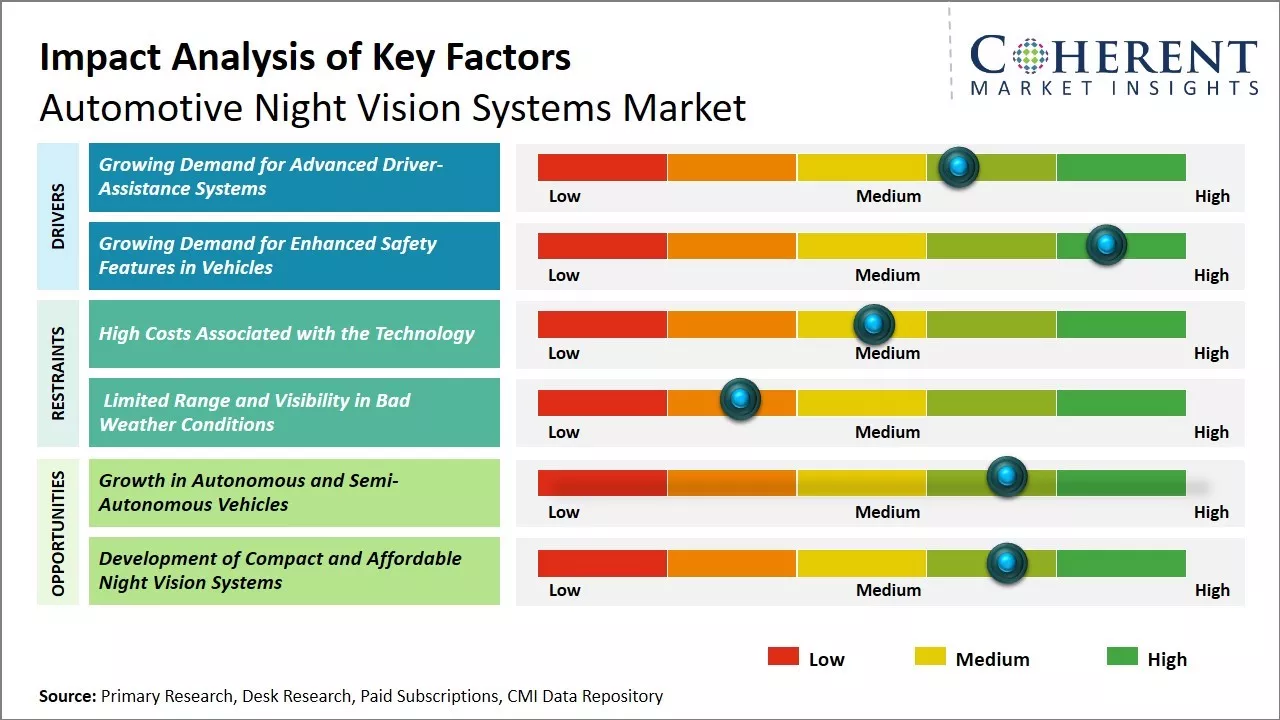
Discover market dynamics shaping the industry: Download Free Sample
The market is expected to witness significant growth during the forecast period. The key factors driving the growth of automotive night vision systems include increasing demand for advanced driver assistance systems (ADAS) and growing concern for road safety. Moreover, positive GDP growth in emerging economies and increasing purchasing power are expected to propel the sales of luxury and high-end vehicles integrated with advanced driver assistance features including night vision systems during the forecast period. However, high development cost of these systems remains a major challenge. Key players in the market are focusing on lowering the costs and enhancing the features to accelerate their adoption in mid-range premium vehicles.
Growing Demand for Advanced Driver-Assistance Systems
The automotive industry has been rapidly adopting advanced driver-assistance systems and technologies that aim to enhance vehicle safety, driver comfort, and autonomous capabilities. Night vision systems, a type of advanced driver assistance system, allow vehicles to detect objects and pedestrians in low-light conditions that the human eye may find difficult to see. As automakers strive to offer customers vehicles with the latest safety and convenience features, night vision has emerged as an important technology.
Night vision utilizes thermal imaging cameras and infrared sensors to detect temperature differences between objects in the roadway like animals, other vehicles, pedestrians and the ambient temperature of the surroundings. The system analyzes the infrared images and displays a video image on a monitor for the driver. This helps to enhance vision and allows for early detection of potential hazards in conditions with poor visibility at night or in bad weather. As autonomous capabilities continue to improve, night vision can also support advanced driver assist features for adaptive cruise control and emergency braking by enhancing object detection capabilities in low light.
Automakers have been quick to recognize the growing demand from customers who want vehicles equipped with comprehensive advanced safety aids. Night vision increases the value proposition as it provides an extra level of safety assurance especially for driving in less than ideal night time conditions which are common in many areas. The feature is becoming increasingly standard even on mid-range models and trims as costs reduce with mass production. With continued technology improvements and higher adoption across model lineups, night vision systems are poised to experience strong growth due to broader emphasis automakers are placing on active safety systems. For instance, in December 2021, Mitsubishi Electric Corporation developed a concept car that is equipped with near-infrared cameras and radio-wave sensors to monitor the driver and passengers and an Advanced Driver Assistance System (ADAS) to provide adaptive control of the headlights, both of which help to avoid traffic accidents.
Market Concentration and Competitive Landscape
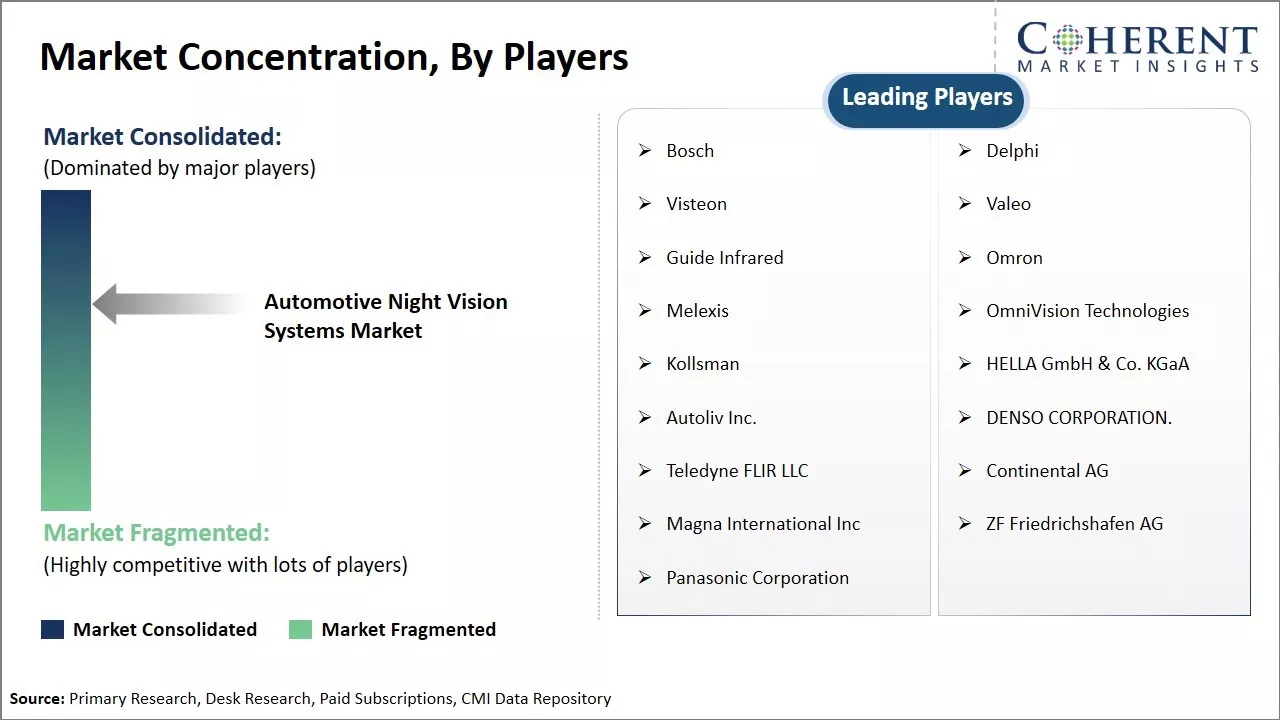
Get actionable strategies to beat competition: Download Free Sample
Growing Demand for Enhanced Safety Features in VehiclesThe demand for enhanced safety features in vehicles has been steadily increasing over the years. With more and more road accidents occurring due to poor visibility at night, the need for advanced night vision systems has become imperative. Automotive night vision systems play a vital role in detecting pedestrians, animals and other obstacles on the road during nighttime driving when visibility is low. They use infrared cameras and sensors to detect heat signatures of humans and animals from a far distance, often more than 300 meters, and present the enhanced image on the in-vehicle display screen. This gives valuable additional time to drivers to react to potential hazards, thereby significantly improving road safety.
More automakers are now recognizing the importance of such active safety systems and are proactively making night vision a standard feature in many luxury and premium vehicles. For instance, as per the U.S. Department of Transportation, nighttime crashes accounted for approximately 25% of total traffic crashes in 2021 with majority related to impaired recognition of pedestrians and wildlife on roads. This alarming stat has prompted even mass market brands to include night vision as an affordable option through lower price tiers. Simultaneously, technological advancements are helping to reduce production costs and make the systems more accessible. Advanced infrared sensors with higher resolution and wider angle of view are allowing vehicles to 'see' further and detect obstacles earlier than before.
With growing consumer awareness about such unique safety aids, night vision is projected to become ubiquitous especially in regions with poor street lighting infrastructure and high deer-vehicle collisions. The European New Car Assessment Programme (Euro NCAP) also plans to incorporate night vision testing in their expanded safety ratings from 2023 which will accelerate its adoption across new models. The aftermarket for retrofitted night vision solutions is likewise gathering momentum. Therefore, increasing policy support coupled with rapidly expanding use cases is expected to catapult the automotive night vision systems market to unprecedented heights in the next five years.
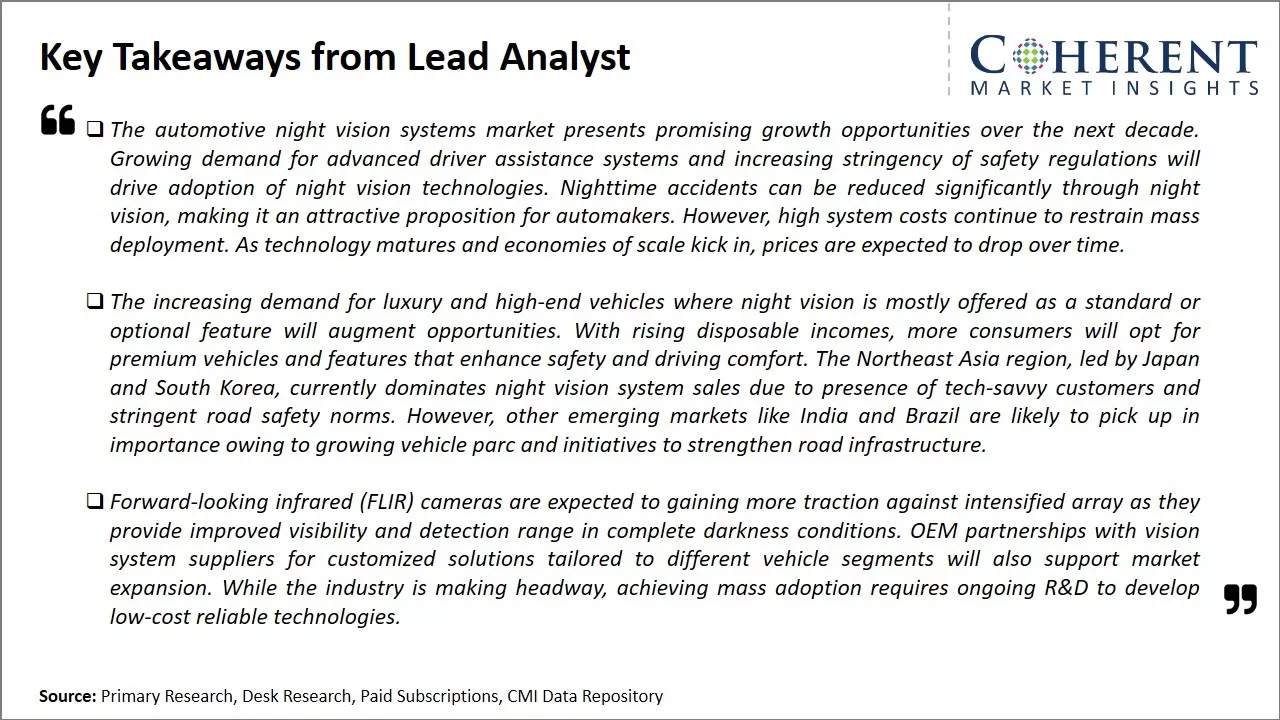
To learn more about this report, Download Free Sample
Market Challenges: High Costs Associated with the TechnologyOne of the major challenges faced by the automotive night vision systems market is the higher costs associated with the technology. The components needed to provide infrared visibility and thermal imaging come at a premium which impacts the overall pricing of vehicles. Additional costs are involved for continuous research and development to improve vision capabilities. There is also the challenge of driver awareness - many drivers may not see the need for or value of these systems until a safety incident occurs. Educating consumers about benefits is an uphill task.
Market Opportunities: Growth in Autonomous and Semi-Autonomous Vehicles
Global automotive night vision systems market provides multiple opportunities for growth. As the technology evolves and costs come down through economies of scale, adoption will increase among mainstream buyers looking for advanced driver assistance systems. With self-driving vehicles on the horizon, night vision capabilities will become critical and demand could surge. Players offering multi-functional systems providing lane departure assistance, blind spot monitoring along with night vision.
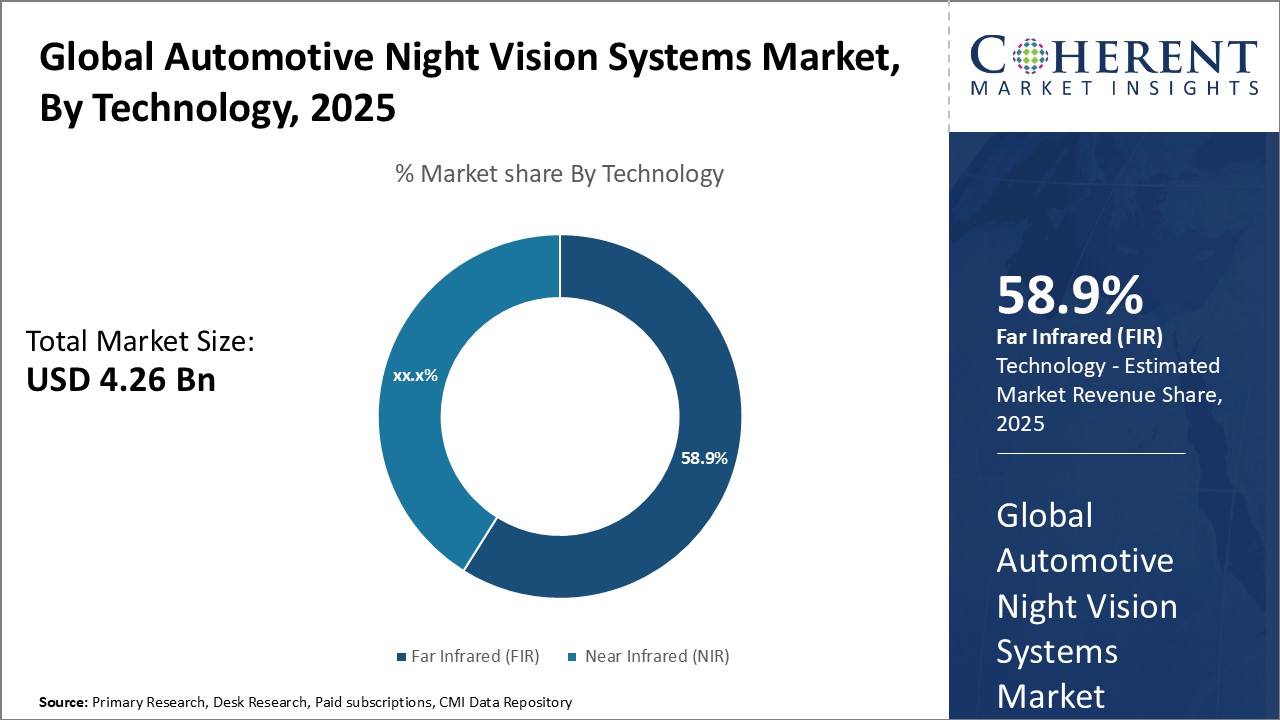
Discover high revenue pocket segments and roadmap to it: Download Free Sample
Insights, By Technology - Advanced Camera Technology Boosts FIR AdoptionFar Infrared (FIR) segment is estimated to contribute the highest share of 58.9% in 2025 in the market owing to its superior object detection capabilities as compared to Near Infrared (NIR). FIR cameras are able to detect the thermal radiation emitted by all objects above absolute zero, including humans and animals. This allows FIR night vision systems to provide the driver a clear picture of the road and surrounding areas even in total darkness or dense fog conditions where visible light is highly restricted.
FIR technology has progressed significantly in recent years with the development of advanced micro bolometer detectors that offer higher resolution, wider fields of view and better sensitivity. This has enabled camera manufacturers to design more compact yet powerful FIR cameras suitable for vehicle integration. The higher resolution provided by latest generation microbolometer detectors allow night vision systems to detect objects from farther distances with greater clarity. These can also process images faster and present alerts to drivers in real time.
Another key advantage of FIR over NIR is its ability to see through light fog, smoke and haze caused due to automobile emissions. NIR systems rely on low level ambient light being reflected off objects for detection. FIR systems circumvent this issue by detecting the heat signature of objects independently of surrounding lighting conditions. This makes FIR night vision a safer choice for commercial vehicles that often operate in adverse weather or pollution.
Automakers have come to recognize FIR as the optimal technology for advanced driver assistance systems that need to reliably detect pedestrians and wild animals especially on darkened rural roads. The push for self-driving vehicles has further accelerated FIR adoption as it provides the computer vision systems more visual data for scene understanding compared to NIR. With continual price reductions due to larger production volumes, OEMs now offer FIR night vision as standard or optional features on many premium models.
For instance, in association with Erae AMS, an automobile parts maker, Hanwha Systems, a South Korea based company, announced development of high-performance night vision technology based on thermal imaging cameras for autonomous driving based on far-range infrared technology.
Insights, By Component- Cameras are the Core Component Driving Systems Adoption
Camera segment is estimated to contribute the highest share of 34.7% in 2025 in the market owing to its critical role in image capturing and object detection functionality. Night vision systems essentially require a thermal camera to record the infrared radiation emitted or reflected by surrounding objects. Sophisticated cameras with high resolution microbolometer detectors have been critical for attracting consumer interest and expanding night vision integration across different vehicle classes.
The camera is one of the most expensive individual components in a night vision system assembly. Continuous technological advancement in uncooled microbolometer fabrication has led to price reductions of nearly 30% over the last five years for OEM-grade cameras. This has encouraged more automakers to include night vision as a standard or optional feature on various mainstream models. High megapixel cameras capturing wider fields-of-view have also improved the value proposition compared to early generation low-resolution night vision aids.
Beyond basic object detection capabilities, automakers expect night vision cameras to support advanced driver assistance features through computer vision and AI/deep learning. This requires higher pixel counts, multi-spectral imaging arrays, and onboard processing units within the camera module itself. Suppliers are responding with modular ‘smart camera’ platforms capable of autonomous functions like pedestrian detection, lane departure warnings etc. Their open architecture eases integration within different ADAS solutions and future roof-mounted ‘drone-like’ applications for self-driving transport.
Though other core components like sensors, displays and control units enable key functionalities, the performance and capabilities of night vision systems remain heavily dependent on the imaging camera.
Insights, By Vehicle Type - Passenger Vehicle Demand Spurs aftermarket Growth
Passenger Vehicle segment is estimated to contribute the highest share of 63.3% in 2025 in the market due to growing demand from premium consumers. Aftermarket installations have emerged as a major avenue for expanding night vision popularity beyond factory OEM integration constrained by budget and pricing negotiations.
Premium passenger vehicles offer suitable rooftop space and accessory power ports for professional night vision system retrofits. Independent aftermarket suppliers address unmet desires for next-gen driver aids among luxury SUV and sports car owners. Modular solutions are easy to install without vehicle disassembly and seamlessly integrate instrument cluster/ infotainment displays. Plug-and-play designs simplified commissioning attracts DIY automotive enthusiasts as well.
Rising safety and active styling consciousness among younger private vehicle users stimulates aftermarket demand. Social media reviews highlighting the ‘wow’ and amusement factor of new night vision experiences have gone viral popularizing their use beyond commercial fleets. Suppliers catering exclusive systems for luxury make/models gain from this niche market demand. Lifestyle affinity and discretionary spending among high net individuals further drive upscale night vision system installations as status symbols.
Off-roading, hunting and recreational vehicle communities represent a lucrative consumer base. Aftermarket providers offer ruggedized solutions optimized for outdoor settings appreciated for enhanced navigation under extreme low-light conditions away from city streets. Customized rearview and multi-camera configurations suit specialty application needs unaddressed by factory packages.
In conclusion, core advantages of the three segments in terms of Technology, Component and Vehicle Type have accelerated their adoption in the automotive night vision systems market. Continued innovation across these segments is expected to make advanced night vision safety more accessible.
Regional Insights
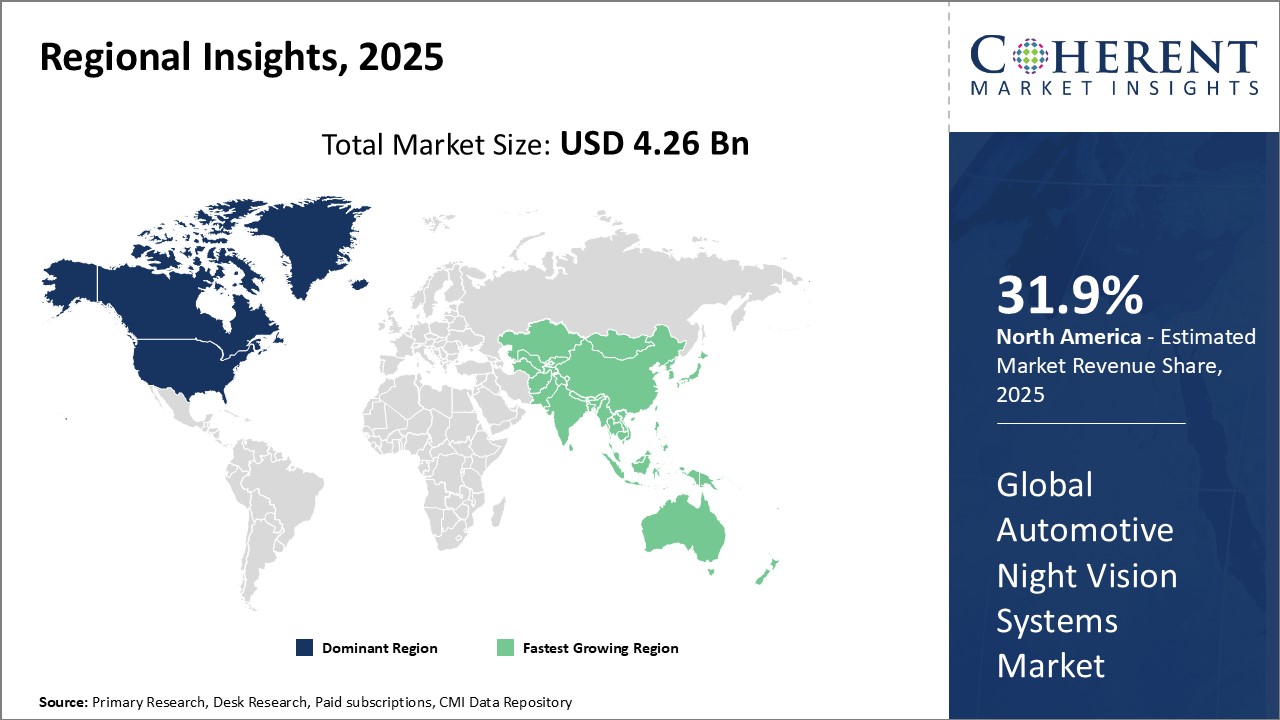
Need a Different Region or Segment? Download Free Sample
North America has been dominating the global automotive night vision systems market for many years with revenue share of 31.9% in 2025. This can be largely attributed to the large automotive production and sales in countries like the U.S. Major automotive manufacturers have their headquarters and extensive operations in the region. Furthermore, increasing concerns about road safety and stringent regulations have prompted automakers to incorporate advanced driver assistance technologies in their vehicles. As night vision systems enhance visibility and help detect pedestrians or animals ahead in low light conditions, their demand has been steadily rising. Several models of luxury cars produced in North America now offer night vision as a standard or optional feature.
Among other regions, Asia Pacific has emerged as the fastest growing market for automotive night vision systems in recent times. Rapid economic development and rising disposable incomes in countries like China and India have led to higher automotive ownership. As the automotive landscape in Asia becomes more sophisticated, manufacturers and customers are paying greater attention to features that enhance convenience and safety. Local production is on the rise as well, with some major automakers setting up manufacturing plants within Asia to cater to the growing in-region demand. This has made night vision systems more accessible to customers due to lower manufacturing and distribution costs compared to imports. With Asia foreseen to dominate global vehicle sales in the coming years, the demand for night vision is expected to accelerate further and boost the region's status as a lucrative market.
The night vision market has matured in North America while Asia Pacific still has strong scope for further penetration. With established automotive industries and customer preference moving towards premium segments, night vision adoption is increasing at a healthy pace in both regions. However, Asia's combination of a vast developing market and strategic production networks within the region puts it in an advantageous position for higher future growth compared to others.
Market Report Scope
Global Automotive Night Vision Systems Market Report Coverage
| Report Coverage | Details | ||
|---|---|---|---|
| Base Year: | 2024 | Market Size in 2025: | USD 4.26 Bn |
| Historical Data for: | 2020 To 2024 | Forecast Period: | 2025 To 2032 |
| Forecast Period 2025 to 2032 CAGR: | 11.6% | 2032 Value Projection: | USD 9.20 Bn |
| Geographies covered: |
|
||
| Segments covered: |
|
||
| Companies covered: |
Bosch, Delphi, Visteon, Valeo, Guide Infrared, Omron, Melexis, OmniVision Technologies, Kollsman, HELLA GmbH & Co. KGaA, Autoliv Inc. , DENSO CORPORATION., Teledyne FLIR LLC, Continental AG, Magna International Inc, ZF Friedrichshafen AG, Panasonic Corporation |
||
| Growth Drivers: |
|
||
| Restraints & Challenges: |
|
||
Uncover macros and micros vetted on 75+ parameters: Get instant access to report
Global Automotive Night Vision Systems Industry News
- In December 2021, Mitsubishi Electric Corporation, a Japanese multinational electronics and electrical equipment manufacturing company, announced that it had developed a new concept car, the EMIRAI xS Drive, equipped with near-infrared cameras and radio-wave sensors to monitor the driver and passengers, and an Advanced Driver Assistance System (ADAS) to provide adaptive control of the headlights, both of which help to avoid traffic accidents.
- In April 2021, Hanwha Systems participated in a consortium led by Erae AMS, an automotive parts maker, and was selected for a project to develop a thermal imaging fusion 3D camera that can respond day and night. By January 2025, the consortium will develop a 3D fusion camera with AI-based deep learning technology that can accurately recognize objects more than 250 meters away in a level 4 autonomous driving environment that requires no intervention from drivers.
- In May 2020, FLIR Systems Inc. released first European Thermal Imaging Dataset for Automotive Driver Assistance Development for machine vision testing. Designed to help auto manufacturers enhance and accelerate work on safety, advanced driver assistance-systems (ADAS), automatic emergency braking (AEB) and autonomous vehicle (AV) systems, the dataset features thousands of annotated thermal images of daytime, nighttime and various weather scenarios from six cities across Europe.
- In December 2020, The VOYAH brand, under Dongfeng Motor Corporation (Dongfeng Motor), launched VOYAH FREE, a mid-sized electric SUV in the mid to large-size category, in Shenzhen. The vehicle is equipped with an advanced night vision system that provides visibility up to 150 meters and features AI-based recognition and alert capabilities.
*Definition: The automotive night vision systems market consists of vision enhancement technologies installed in vehicles that use infrared cameras and sensors to detect people, animals and objects on the road beyond the reach of the headlights in low-light or night time conditions. Night vision systems provide enhanced visibility to the driver and can display detected objects on dashboard screens to help drivers spot potential hazards earlier than with normal headlights alone.
Market Segmentation
- Technology Insights (Revenue, USD Bn, 2020 - 2032)
- Far Infrared (FIR)
- Near Infrared (NIR)
- Component Insights (Revenue, USD Bn, 2020 - 2032)
- Camera
- Sensors
- Display Units
- Control Units
- Others
- Vehicle Type Insights (Revenue, USD Bn, 2020 - 2032)
- Passenger Vehicle
- Commercial Vehicle
- Regional Insights (Revenue, USD Bn, 2020 - 2032)
- North America
- U.S.
- Canada
- Europe
- Germany
- U.K.
- France
- Italy
- Russia
- Spain
- Rest of Europe
- Asia Pacific
- China
- India
- Japan
- Australia
- South Korea
- ASEAN
- Rest of Asia Pacific
- Latin America
- Brazil
- Argentina
- Mexico
- Middle East & Africa
- GCC Countries
- Israel
- South Africa
- Rest of Middle East
- North America
- Key Players Insights
- Bosch
- Autoliv
- Delphi
- Visteon
- Valeo
- Guide Infrared
- Omron
- Melexis
- OmniVision Technologies
- Kollsman
- HELLA GmbH & Co. KGaA
- Autoliv Inc.
- DENSO CORPORATION.
- Teledyne FLIR LLC
- Continental AG
- Magna International Inc
- ZF Friedrichshafen AG
- Panasonic Corporation
Share
Share
About Author
Gautam Mahajan is a Research Consultant with 5+ years of experience in market research and consulting. He excels in analyzing market engineering, market trends, competitive landscapes, and technological developments. He specializes in both primary and secondary research, as well as strategic consulting across diverse sectors.
Missing comfort of reading report in your local language? Find your preferred language :
Transform your Strategy with Exclusive Trending Reports :
Frequently Asked Questions
EXISTING CLIENTELE
Joining thousands of companies around the world committed to making the Excellent Business Solutions.
View All Our Clients
